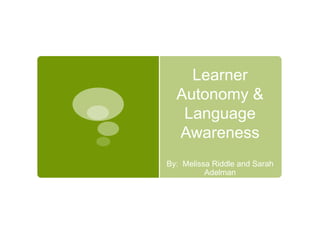
Learner Autonomy and Language Awareness
- 1. Learner Autonomy & Language Awareness By: Melissa Riddle and Sarah Adelman
Notas del editor
- From a philosophical point of view one of the desirable though not easily achievable, goals of general education has always been to create autonomous individuals who are willing and able to think indepently and act responsibly.
- Cognitive-learning is very effective if the learner integrates knowledge within a personal framework Humanistic- emphasizes the promotion of learner’ self-esteem through personal ownership of learning Educational- posits a strong connection between learner autonomy and learner motivation
- Self-Instruction- situations in which learners are working without the direct control of the teacher Self-Direction- situations in which learners accept responsibility for all the decisions concerned with learning but not necessarily for the implementation of those decisions Self- Access- situations In which learners make use of self-access teaching material or instructional technology that is made available to them Individualized Instruction- situations in which the learning process is adapted either by the teacher or by the learner to suit the specific characteristics of an individual learner These terms show there is a varying degree of learner involvement and teacher engagement.
- Taking Charge= to have and to hold the responsibility for determining learning objectives, defining contents and progressions, selecting methods and techniques to be used, monitoring the procedure of acquisition and finally evaluating what has been acquired.
- Direct- memory strategies-remembering and retrieving new information cognitive strategies-understanding and producing the language compensation strategies- making do with limited, still-developing proficiency Indirect- metacognitive-coordinating learning process affective strategies- regulating emotions and attitudes social strategies- learning and working with others Page 136 Important to remember there are many individual ways of learning a language successfully and there will be different students who approach language learning differently.
- Successful learner training includes psychological as well as strategic preparation A crucial task of the teacher wishing to promote learner autonomy is to help learners take responsibility for their learning, and to bring about necessary attitudinal changes in them. Learner training “aims to provide learners with the alternative from which to make informed choices about what, how, why, when, and where they learn.
- Actively seeking to help learners recognize sociopolitical impediments placed in their paths to progress and by providing them with the intellectual tools necessary to over come them.
- Investigate and understand how language rules and language use are socially structured About issues that directly engage their sense of who they are and how they relate to the social world Where learners develop into unified socially cohesive mutually supportive groups - In cyberspace, online services,
- We can’t assume academic autonomy is only for learners of lower proficiency and liberatory autonomy is for learners of higher proficiency. Autonomy is a complex structure that can be understood only through careful study and achieved only through continual struggle. Autonomy requries teachers who are wiling to let go and learners who are willing to take hold.